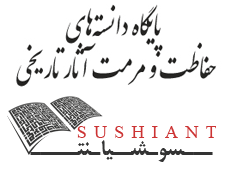فرشاد مؤذنی ریزی
ارائهی راهکارهای عملیِ استفاده از سطوح بافتدار گچی به منظور بازسازی کمبود در اندودها و تزئینات گچی معماری
پایاننامهی کارشناسی ارشد،
دانشگاه هنر اصفهان (دانشکدهی حفاظت و مرمت)، 1392
استاد راهنما: حسام اصلانی
استاد مشاور:
امیرحسین کریمی
چکیده:
مرمت آثار تاریخی نه تنها رویکردی در راستای حفاظت و نگهداری از آثار تاریخی مطرح میشود، بلکه در هر چه بهتر شدن سیمای ظاهری آثار به بیان راهکار میپردازد. مهمترین شاخصهها در این زمینه در نظر داشتن اصالت تاریخی و اصل زیباییشناسی اثر است. در این پژوهش به بررسی بخشهای تخریب شدهی اندودها و تزئینات گچی معماری، بهعنوان یکی از این اختلالات پرداخته شده است و تاکید اصلی آن بر روی بازسازی بستر در کمبودها است. چرا که بههمان میزان که نوع رنگ و نحوهی رنگگذاری حساس و با اهمیت است تدارک بستری مناسب برای رنگ نیز قابل توجه میباشد و در این راستا تمرکز اصلی بر روی بافت این سطوح قرار میگیرد. همچنین به بررسی جایگاه صحیح استفاده از سطوح زبرهی گچی در بازسازی انواع کمبودها پرداخته میشود. در واقع اهداف اصلی در این پژوهش بررسی درستی یا نادرستی روشهایی است که در بازسازی بستر کمبودها در اندودها تزئینات گچی معماری در ایران بهکار گرفته میشود و در نهایت دستیابی به شیوهای عملی جهت اجرای بهینهی سطوح زبرهی گچی است تا مرمتگران بتوانند با بهکارگیری آن در بهبود کیفیت کار تلاش کند و یا با استفاده از آن به پرورش نیروی متخصص جهت اجرای سطوح بپردازند. مطالعات بر پایهی دو فرضیه پیگیری شد ۱- استفاده از اندود بافتدار راه حل مناسبی برای بازسازی کمبودها در اندود و تزئینات معماری است. ۲- با کنترل دانهبندی، رعایت زمانبندی مراحل اجرای اندود با توجه به گیرش ملات و استفاده از افزودنیهای رنگی، میتوان به اندودهای زبرهی مناسب جهت بازسازی انواع کمبودها دست یافت. در بررسی فرضیات از منابع کتابخانهای، مصاحبه، آزمایش و نمونهسازی استفاده شد. با توجه به بررسیها و مطالعات انجام شده کمبودها به سه نوعِ؛ کمبودهای کوچک، کمبودهای غیر قابل بازسازی و کمبودهای بزرگ قابل بازسازی رنگی تقسیم بندی شد و نقش بافت در بازسازی بستر این کمبودها مورد بررسی قرار گرفت. در کمبودهای کوچک، بافتی مشابه بافت سطوح اصلی پیشنهاد شد. برای کمبودهای غیر قابل بازسازی سطحی با بافت نسبتا خشن توصیه شد که به نوعی بازسازی لایهی آستر تزئینات محسوب میشود و برای کمبودهای قابل بازسازی سطحی بافتدار با بافتی نرمتر اما متفاوت با سطوح اصلی در نظر گرفته شد. در اجرای سطوح بافتدار تنظیم دانهبندی مهمترین عامل در دستیابی به بافت مناسب است. در این راستا عمل آوری ملات و زمانبندی در انجام مراحل میتواند در سهولت و کیفیت کار بسیار موثر باشد و بهتر است ملات بدون هیچگونه افزودنی استفاده شود.
Abstract: Restoration of historical monuments is considered not only as an approach to conservation and protection of monuments, but also it gives some expression solution to improvement of the appearance of these monuments. The most important points in this field are considering historical authenticity and aesthetic of monument. Along time, various damaging factors have caused disorders in these historical monuments. This research, has dealt with survey of parts of destroyed plastered decorations in Architecture as one of these disorders and main has emphasis on Reconstructing using intonaco in the lacunas, because providing suitable intonaco is as important and sensitive as type of paint and how to painting, so mainly focus is on the texture of these surfaces. As well it has been dealt with survey of correct using of textured gypsum surfaces in Reconstructing types of lacunas. Indeed, the main objectives of this study are survey of accurate or inaccurate methods for reconstructing of intonacos lacunas in the architecture plaster decorations coatings that are used in Iran and achieving a practical way for optimum performance of leveled textured gypsum surfaces in order to restorers be able to improve the quality of work, and or by using of that be able to train expertise for surfaces implement. The studies follow based on the two hypotheses: 1. Using of fabric coating is a suitable solution for reconstructing lacunas in coating and architecture decorations. 2. Controlling of granular, setting time of process of coating implement considering setting mortar and use of colored additives, can achieve to suitable textured gypsum surfaces in order to reconstruction kind of coatings. References of library, interview, test and modeling was used for surveying of hypotheses. Considering surveys and studies about lacunas, they were divided to three kinds: small lacuna, non-reconstruction able lacuna and large reconstruction-able lacuna; and the role of texture in reconstruction of bed of these lacuna was surveyed. Similar to texture of main surfaces was proposed in small textural lacunas. A surface with relatively rough texture was recommended for non-reconstruction able lacunas that consider as a reconstruction of arriccio, and for reconstruction-able lacuna, a surface with softer texture but different from main surface was considered. The most important factor in implementing of textured surfaces is particle size in order to achieving suitable texture. Therefore, mortar curing and timing of processes can be very effective in facility and quality of work and that is better mortar is used without any additive.
